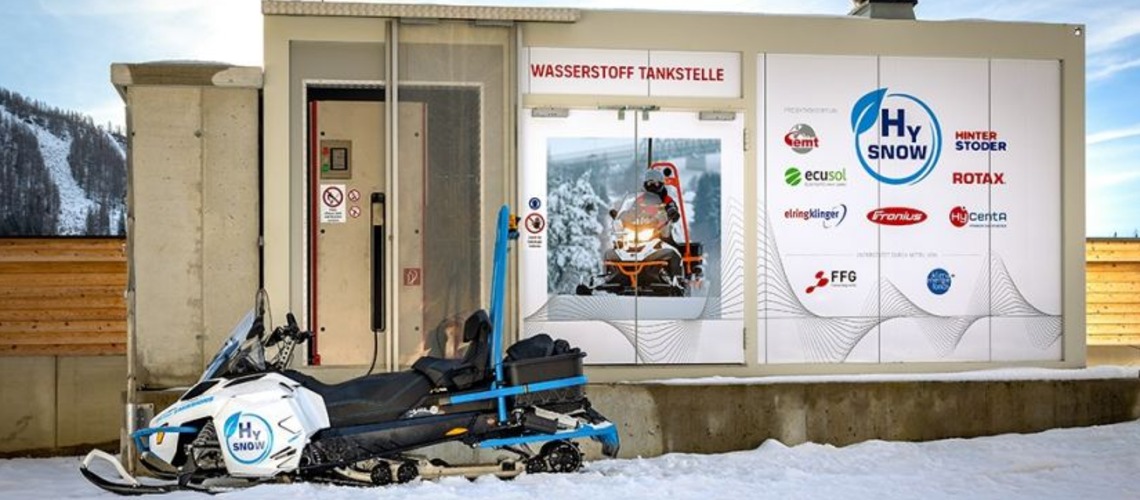Rotax Hydrogen Powered Snowmobile Lynx Hysnow Used On Slopes For First Time

Especially in winter sports areas, the reduction of noise and pollutants as well as the use of renewable energy sources are a constantly growing topic. In order to promote the decarbonization of winter tourism, the Upper Austrian company BRP-Rotax developed a snow vehicle powered by hydrogen fuel cells. Now the Lynx HySnow and the supplementary hydrogen refueling system, which generates green hydrogen on site, are in real operation for the first time in the Hinterstoder ski area.
- The Lynx HySnow concept snow vehicle presented in 2020 is now in real operation in the Hinterstoder ski area with green hydrogen from its own refueling system
- The HySnow hydrogen project promotes the competitiveness of Austria and contributes to the decarbonisation of winter tourism
- Further investments in the industrialization and series production of fuel cell-based vehicles are decisive
- The HySnow project funded by the Climate and Energy Fund as part of its “Lighthouses of E-Mobility” program and implemented in cooperation with HyCentA Research GmbH, Fronius International GmbH, the Technical University of Graz, the Hinterstoder and Wurzeralm ski region as well as ElringKlinger AG and of ECuSol GmbH
As part of the FIS Ski World Cup in February 2020, the team around the project management of the R&D department at Rotax presented the concept vehicle and the associated infrastructure solution to the public after four years of research. Despite the corona pandemic, the overall system consisting of a photovoltaic and hydrogen production system, hydrogen refueling system and snowmobile was then able to go through an intensive test phase in Hinterstoder under real conditions. This confirmed the safety and reliability of the innovation, including the desired range per refueling, even at extreme ambient temperatures.
Holistic hydrogen ecosystem in Hinterstoder
The Lynx HySnow, which only emits water vapor and drives almost silently, scores with a high-torque electric drive and good operating options in cold temperatures. After one and a half years of experimental development on the test bench and in the vehicle, the fuel cell system can now already show 120 operating hours. In addition, the Rotax vehicle is embedded in a true hydrogen ecosystem: the central core of the project is the hydrogen production and refueling system, which was developed in collaboration with Fronius. It generates green hydrogen for the vehicle right next to the runway. With the electrolysis modules, 50 kg of hydrogen could be produced in 300 operating hours.
The electricity for electrolysis is obtained from green photovoltaic electricity, this system was planned and built by ECuSol GmbH. The decisive advantage of the hydrogen system is the fast refueling time of the vehicles of less than three minutes. In addition, large amounts of energy can be stored easily. This ensures the supply of hydrogen for a month and a half even with a snow-covered photovoltaic system. Real operation will take place over two winter seasons, which will save four tons of CO2 emissions compared to vehicles with internal combustion engines. With solar energy in summer it is even possible to save eleven tons of CO2. The flagship project receives financial support from the Climate and Energy Fund.
Despite the successes, the further development of emission-free hydrogen technology continues to be challenging. “In particular, the availability of suitable and inexpensive system components is still very limited,” said Wolfgang Rapberger, GM BRP-Rotax / Representative of the Management Board, about the ongoing project. “In the next step, we would like to direct a special focus on industrialization, modularization and complexity reduction. With Fronius as infrastructure supplier, ElringKlinger as fuel cell stack supplier and BRP as vehicle supplier, a powerful unit has been formed. "
Foundation stone for future series production
“We are pleased to finally see the Lynx HySnow in real operation on the slopes and thus to celebrate an important milestone in sustainable drive systems. However, the project is not only essential for alpine use. Our project is intended to promote the competitiveness of our state in the hydrogen sector and lay the foundation for future series production of fuel cell-based vehicles, ”said Wolfgang Rapberger.
The Hinterstoder and Wurzeralm ski region, partner of the HySnow project, is looking forward to the upcoming test phase in everyday use. “All lift systems and snow-making systems in the two ski areas Hinterstoder and Wurzeralm have always been supplied from renewable energy sources. It is therefore very important to me that we manage the switch from fossil fuels to renewable energy in the area of snowmobiles and snow groomers as well. We are proud to be able to try out a climate-neutral tourism business as a model region ”, says Helmut Holzinger, director of the Hinterstoder-Wurzeralm Bergbahnen AG.
Hydrogen as an opportunity for Austria as a research and business location
The HyCentA of the Graz University of Technology, one of the largest research facilities for hydrogen in Europe, played a key role as a project partner in the development of the green hydrogen ecosystem around the Lynx HySnow. Alexander Trattner, managing director and scientific director of HyCentA Research GmbH, clearly sees the future of mobility in this type of renewable energy: “The special thing about the HySnow project is that the proof of clean and safe hydrogen mobility is not just in the laboratory, but on a real scale is provided in alpine environmental conditions. For this purpose, the HySnow system uses its own renewable resources on site by means of photovoltaics and generates completely emission-free hydrogen through electrolysis of water. The electric HySnow drive concept consisting of a fuel cell,
With around 20 years of experience, Fronius is a pioneer when it comes to green hydrogen. Martin Hackl, Global Director Sales & Marketing at Fronius International, is convinced that "the decarbonization of mobility can only succeed if hydrogen is produced ecologically." "With our Solhub we have already implemented a decentralized compact system for the generation, storage and use of green hydrogen and brought our know-how to the HySnow project." For even more innovations from Austria, Fronius will in future be bundling all of its expert knowledge on its new high-tech hydrogen -Competence center in Steinhaus.
In the fuel cell stack, hydrogen is converted into electrical current with ambient air. The “NM5” stack platform used was developed by the project partner ElringKlinger and produced fully automatically. With series production planned for the end of 2021, ElringKlinger will make a significant contribution to the widespread use of fuel cell technology in mobile applications.
In order to help the sustainable energy carrier hydrogen make a breakthrough, the next step is to work on industrialization options. In the future, these could enable cost-effective, series production of fuel cell-based vehicles and H2 storage media. Further research projects are intended to support this project.














